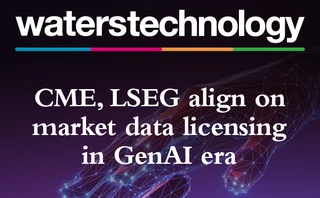Corporate Actions: Past, Present and Future

Over the past five years, we have probably witnessed more changes in ‘corporate actions’ than any other five-year period. The most encouraging sign is not necessarily the change itself, but that the changes have required a level of collaboration that demonstrates how committed many individuals, firms and industry organizations are to making a difference. We need to maintain this commitment to ensure the next five years are equally as productive.
From the good work of the Corporate Actions Joint Working Group in Europe, which brought together industry participants, organizations, issuers and regulators to address some problematic but conceptually simple changes—for example, introducing and standardizing record dates for many bearer-based markets—to the key contributions from a number of Central Securities Depositories such as Euroclear, Clearstream, the Depository Trust and Clearing Corporation, Japan Securities Depository Center and Mexico’s securities depository Indeval through their re-engineering projects, the needs of the markets are beginning to be met. Indeed, once committed to change, other challenges can be faced. By introducing the issuers to the straight-through processing (STP) discussion through the efforts of the ‘Issuer to Investor: Corporate Action’ initiative in the US, orchestrated by the DTCC, Swift and XBRL US, to the work of Euroclear and Clearstream on their International Securities Market Advisory Group initiative to harmonize issuance and asset servicing processes, changes can be envisioned and realized.
A common thread that all the above organizations and associations, amongst others, have is a commitment to work towards a standardized corporate actions model, encompassed by a strong market practice, as most recently documented by the International Securities Services Association. It bears emphasizing that wholesale changes have to be based upon a common vision or model, otherwise participants in global markets will not fully uncover the benefits of improvement. Therefore, the work of the Securities Market Practice Group and the supporting organizations such as ISITC in North America and the Market Data Provider User group, should be applauded.
A number of challenges have remained, however, which will require certain measures to be taken:
1. All parties need to be committed to change. Building upon the collaboration underway, all parties from issuer, infrastructures, custodial banks, brokers, investment managers and ultimately the investor, must recognize the need to support each other. Real benefits are wholesale. Individual firms can improve their internal processes, but to get meaningful improvement all parties must recognize how to effectively work and communicate with others.
2. All parties need to invest. With commitment comes investment. Global custodians can have all the latest tools, but if their clients are sending faxes due to lack of investment, nobody wins.
3. All parties need to agree on a corporate action model. ISO 20022 should provide a framework to really define the end game. Don’t let any confusion around ISO 15022 and ISO 20022 create a hindrance to change—in essence, it is one model supported by different formats. Although the sooner ISO 15022 is retired the better.
Future challenges will require us to:
1. Recognize each data element has a single owner, in particular, the announcement, as only the issuer, exchange or depository can provide such key data elements as payment rate, ex-date and allocation date. Each party should be engaged and have the mechanism to provide such information to all investors and the markets.
2. Recognize data needs to flow seamlessly through and between organizations without alternation. If you stop and think what STP really means for corporate actions, where there is reliance on common data, then automatic verification of accuracy needs to be addressed.
3. Recognize the benefits of implementing changes. Imagine all parties are connected, with instantly verifiable information, operating under a common model that supports the needs of all parties. Issuers and investors are linked, in near real-time, throughout the world. Consequently, changes can be implemented fairly easily. Then, perhaps we can address the anarchic reliance upon paper processes that govern many current regulations, such as UK rights issues, or more easily adopt future regulations, such as the US Dodd-Frank Act (in particular, requirements under the Office of Financial Research) and the US IRS new rules on cost basis reporting.
By introducing solutions that individually or collectively meet all parties’ needs while managing undue risk and cost that is passed onto others, we may begin to finalize what it means to process a corporate action. Whether this can be accomplished in the next five years remains to be seen.
Only users who have a paid subscription or are part of a corporate subscription are able to print or copy content.
To access these options, along with all other subscription benefits, please contact info@waterstechnology.com or view our subscription options here: https://subscriptions.waterstechnology.com/subscribe
You are currently unable to print this content. Please contact info@waterstechnology.com to find out more.
You are currently unable to copy this content. Please contact info@waterstechnology.com to find out more.
Copyright Infopro Digital Limited. All rights reserved.
As outlined in our terms and conditions, https://www.infopro-digital.com/terms-and-conditions/subscriptions/ (point 2.4), printing is limited to a single copy.
If you would like to purchase additional rights please email info@waterstechnology.com
Copyright Infopro Digital Limited. All rights reserved.
You may share this content using our article tools. As outlined in our terms and conditions, https://www.infopro-digital.com/terms-and-conditions/subscriptions/ (clause 2.4), an Authorised User may only make one copy of the materials for their own personal use. You must also comply with the restrictions in clause 2.5.
If you would like to purchase additional rights please email info@waterstechnology.com
More on Trading Tech
Banks hope new axe platform will cut bond trading costs
Dealer-backed TP Icap venture aims to disrupt dominant trio of Bloomberg, MarketAxess and Tradeweb.
Editor’s Picks: Our best from 2025
Anthony Malakian picks out 10 stories from the past 12 months that set the stage for the new year.
The next phase of AI in capital markets: from generative to agentic
A look at some of the more interesting projects involving advanced forms of AI from the past year.
Will overnight trading in equity markets expand next year? It’s complicated.
The potential for expanded overnight trading in US equity markets sparked debate this year, whether people liked it or not.
WatersTechnology latest edition
Check out our latest edition, plus more than 13 years of our best content.
The total portfolio approach gains momentum: Building the right tech foundation for success
The rationale for the TPA, and the crucial role technology plays in enabling such an approach
Google, CME say they’ve proved cloud can support HFT—now what?
After demonstrating in September that ultra-low-latency trading can be facilitated in the cloud, the exchange and tech giant are hoping to see barriers to entry come down.
Institutional priorities in multi-asset investing
Private markets, broader exposures and the race for integration







